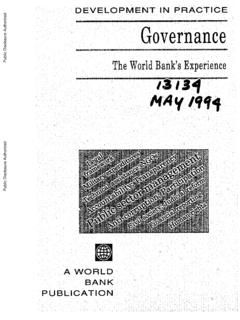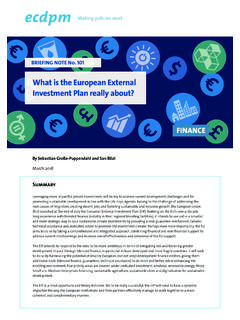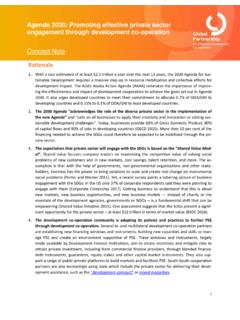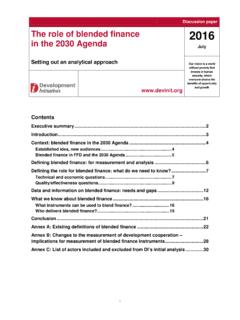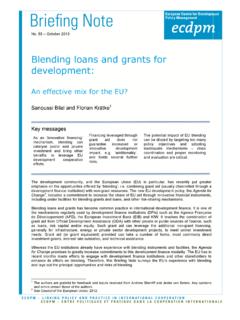Transcription of Blended Financing for the Expansion of the As …
1 CASE STUDIES IN Blended finance FOR WATER AND SANITATIONB lended Financing for the Expansion of the As- samra wastewater treatment Plant in JordanAugust 2016 Summary OverviewLocation: Amman and Zarqa, jordan , Middle East and North Africa Approach to Blended finance : A Blended financial package was put in place to finance the Expansion of the As- samra wastewater treatment Plant. The project was undertaken by the samra wastewater treatment Plant Company Limited (SPC), a private operator that was recruited through a Build-Operate-Transfer (BOT) contract to finance , upgrade, and operate the treatment plant. The private operator was required to mobilize private Financing , which it did through an equity contribution and a syndicated limited recourse loan provided by domestic banks in local currency.
2 The overall financial package also included public funds provided as viability gap fund-ing (VGF), including contributions from the Government of jordan and a grant from the Millennium Challenge Corporation (MCC). Public funding was critical to help structure the deal and to convince private financiers to step in and provide what was, at the time, the longest maturity ever achieved for a Jordanian dinar-denomi-nated limited recourse loan. ContextJordan is one of the most water-scarce countries in the world. Available water resource levels have fallen with an annual per capita quantity of water approximated at 155 m3 as of 2013. While water demand outstrips supply, it is estimated that two-thirds of available water resources are used for agriculture.
3 Scarce water resources com-bined with high population growth have caused extensive stress on water infrastructure, requiring rehabilitation and extension work. Water scarcity is considered the most important natural constraint to growth and development in the country. The As- samra wastewater treatment Plant was initially designed in 2003 to treat wastewater for the million inhabitants of Amman, while supplying quality irrigation water to the surrounding region. Construction of the plant was completed in 2008. However, the country s rapid population growth and a large influx of refugees led to the approach of the plant s capacity limits (both in terms of the volume of wastewater received and solids processing) sooner than anticipated.
4 For this reason, the Government of jordan , through the leadership of the Ministry of Water and Irrigation (MWI), prioritized the Expansion of the treatment plant in order to meet the needs of the population in two of jordan s most popu-lous cities, Amman and Zarqa. ARAB EGYPTSAUDIARABIAISRAELWEST BANKAND GAZALEBANONSYRIANA. EGYPTSAUDIARABIAISRAELWEST BANKAND GAZALEBANONSYRIANA. 42436 | AUGUST 2016 Public Disclosure AuthorizedPublic Disclosure AuthorizedPublic Disclosure AuthorizedPublic Disclosure Authorized2 Water Global PracticeCase Studies in Blended finance for Water and Sanitation: Blended Financing for the Expansion of the As- samra wastewater treatment Plant in JordanFinancial Structure and Approach to Blended FinanceThe Millennium Challenge Corporation (MCC) committed to assist the MWI with the Expansion project by providing transaction advisors and viability gap funding (VGF).
5 This proved crucial to securing private Financing for expan-sion of the wastewater treatment plant through a build-operate-transfer (BOT) contract, a form of public-private partnership. The BOT contract was signed in 2012 between the MWI and samra wastewater treatment Plant Company Limited (SPC), a private company whose investors include Morganti, Infilco Degr mont, and Suez Environment. Responsibilities for Financing , project design, construction, operation, and maintenance were awarded to the SPC for a 25-year period. Construction on the Expansion began soon after financial closure, and the project became operational in October 2015. The plant Expansion was a key part of a water re-use program that also improved the allocation of water resources by enabling the use of high-quality treated wastewater from As- samra in agriculture, thereby freeing up freshwater for higher value use in municipalities.
6 The diverse blend of Financing that was accessed to fund the US$223 million project is what makes this a unique case. MCC provided a US$93 million grant for the Expansion of the As- samra wastewater treatment Plant, while the Government of jordan contributed an addi-tional US$20 million. Donor and public funding, which can be referred to as viability gap funding , was critical for leveraging an additional US$110 million in private Financing , including US$102 million from private debt and US$8 million in equity mobilized by the debt was secured through a standard project finance limited recourse loan, from a syndicate of Jordanian local banks and financial institutions arranged by the Arab Bank.
7 The limited recourse loan tenor is for 13 years, with an option to extend up to 20. At the time, this was the longest maturity that had ever been obtained for a Jordanian dinar-denominated limited recourse loan. Additional security was ensured through a cash waterfall account structure, and the agreement included step-in rights for the banks. The denomination of the loan in local currency provided the clients with protection against foreign exchange risk. The interest rate during the three-year construction period for the treatment plant Expansion was fixed ( percent during year one; percent during year two; and per-cent during the final year).
8 Following the commissioning of the plant, the loan evolved to a floating rate linked to the average prime lending rate of four local banks. FIGURE 1 Viability Gap Financing for the As- samra wastewater treatment Plant Expansion , jordan : Financial StructureLegendSupply of FinanceRepayment FlowsPublic/DonorAgenciesPrivate FinanciersFinancialIntermediaryService Provider samra wastewater TreatmentPlant Company (SPC)As- samra WastewaterTreatment Plant Project SponsorsSuez Environment/IDI/Morganti-CCCL ender Syndicateled by Arab BankGovernment of jordan :Ministry of Water andIrrigation (MWI)Millennium ChallengeCorporation (MCC)Revenues/ProjectCash FlowsDebt ServiceLimited Recourse LoanGrantGovernmentContributionViability Gap Studies in Blended finance for Water and Sanitation.
9 Blended Financing for the Expansion of the As- samra wastewater treatment Plant in JordanPayments from the MWI are guaranteed through a reserve account, the replenishment of which is in turn backed by a guarantee from the Ministry of finance . Figure 1 illustrates the financial structure for the expan-sion critical component in the financial structure is the existence of an efficient securitization of cash flows from the original plant (constructed between 2003-2008) to support the equity element of the Financing (from project sponsors) invested in the Expansion project. This meant the sponsors were able to invest internal cash flow from the original project as equity.
10 The resulting debt-to-equity ratio is 80:20, including investments from the original plant. While the grant funding from MCC increased the investment appeal to private investors, the financial structure was designed to ensure that the grant would not subsidize the private sector participants, and instead be directed to benefit consumers connected to the sys-tem. The SPC project sponsors investment returns are thus based on their portion of the capital As- samra wastewater treatment Expansion project became operational in October 2015. In line with its origi-nal design, the Expansion increased the average daily capacity of As- samra to treat wastewater from 267,000 to 365,000 m3 per day (over a one-third increase).



